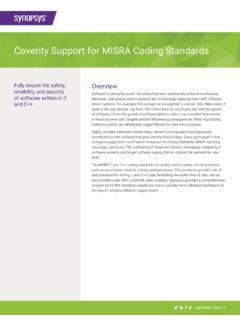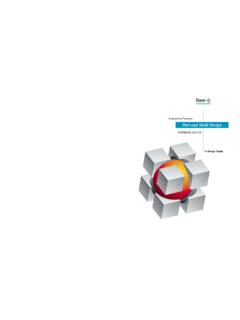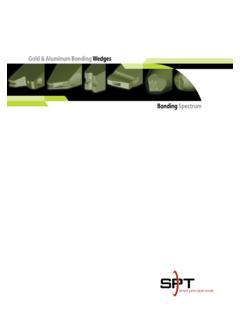Transcription of Sentaurus TCAD - Synopsys
1 DatasheetSentaurus TCAD Industry-Standard Process and Device SimulatorsOverviewSentaurus is a suite of TCAD tools which simulates the fabrication, operation and reliability of semiconductor devices. The Sentaurus simulators use physical models to represent the wafer fabrication steps and device operation, thereby allowing the exploration and optimization of new semiconductor devices. The Sentaurus TCAD tools work seamlessly and can be combined into complete simulation flows in 2-D and 3-D. Sentaurus TCAD supports silicon and compound semiconductor technologies, covering a broad range of semiconductor Applications:``CMOS, FinFET ``Memory (DRAM, NVM)``Power Devices (Si, SiC, GaN)``RF Devices (GaAs, InP, GaN)``Optoelectronics (CIS, Solar Cells, Photodetectors)``BEoL ReliabilityValue of Sentaurus TCAD in Technology Development and OptimizationSemiconductor manufacturers face the challenge of developing process technologies within strict time and cost constraints.
2 One key factor impacting development time and cost is the number of engineering wafers needed to complete the development of the new process. By simulating the process flow and device operation before any wafers are processed and during wafer-based process optimization, TCAD reduces the number of engineering wafers, saving time and money. Morever, Sentaurus TCAD simulations provide engineers with important insights on the behavior of semiconductor devices which can lead to new device concepts. Benefits``Reduces technology development time and cost ``Supports fast prototyping, development, and optimization of a broad spectrum of semiconductor technologies with comprehensive physics-based process-modeling capabilities``Provides insight into advanced physical phenomena through self-consistent multidimensional modeling capabilities, improving device design, yield, and reliability``Provides full-flow 3-D process and device simulation flows, with advanced structure generation.
3 Meshing and numericsSentaurus TCAD SuiteProcesssimulationSentaurus ProcessSentaurus TopographyDevice andinterconnectsimulationSentaurus DeviceRaphaelSentaurus InterconnectSentaurus Structure EditorStructureeditingFrameworkSentaurus WorkbenchSentaurusVisualSentaurusPCMS tudioSentaurus TCAD 2 Sentaurus ProcessSilicon Process SimulatorSentaurus Process simulates the fabrication steps in silicon process technologies in 2-D and 3-D. Equipped with a set of advanced process models, which include default parameters calibrated with data from equipment vendors, Sentaurus Process provides a predictive framework to simulate a broad spectrum of technologies, ranging from nanoscale CMOS to high-voltage power devices.
4 With Sentaurus Process, users can easily simulate process modules and integrate them into complete front end of line (FEoL) process flows. An advanced set of oxidation, diffusion, implantation, and mechanics models, combined with robust mesh generation and structure-editing capabilities, cover important process modules such as ultrashallow junction formation, high-k/metal gate, and strained silicon. A choice of advanced implantation and diffusion models are available in Sentaurus Process. Analytic implant tables cover an extensive energy range, from sub-keV to several MeV. Efficient and accurate Monte Carlo implantation models handle conditions not well covered by the analytic models such as sidewall doping of narrow trenches.
5 SRAM Cell simulated in Sentaurus ProcessIn ultrashallow junction processing, the continual reduction in thermal budgets demands increasingly complex diffusion, clustering, and interface trapping models to achieve an optimum trade-off between minimizing transient-enhanced diffusion and maximizing dopant activation. Spike and laser annealing leads to nonequilibrium point defect dopant pair concentrations and dynamic clustering. To handle these process conditions, Sentaurus Process includes a five-stream diffusion model as well as models for {311} defects, small interstitial clusters (SMICs), dopant-defect clusters, and transient dopant activation.
6 With process-induced stress being a key technique for enhancing device performance, Sentaurus Process computes all major sources of mechanical stress derived from volumetric changes, thermal and lattice mismatches, and deposited thin films. The complete stress history during processing can be simulated and the resulting stress field can be seamlessly exported to Sentaurus Device for evaluating its effect on electrical performance. A model interface language allows the prototyping and implementation of new models to keep pace with rapid technological innovation. With this versatile tool, new diffusion, clustering, silicidation, and oxidation models can be readily Process also offers a kinetic Monte Carlo (KMC) simulator for atomistic simulations of the interactions of dopants with point defects and extended defects in silicon.
7 Sentaurus TopographyPhysical Topography SimulatorSentaurus Topography simulates topography modifying process steps such as deposition, etching, spin-on-glass, reflow, and chemical-mechanical polishing in 2-D and 3-D. Sentaurus Topography includes models for the following deposition processes:``Physical vapor deposition (PVD)``Chemical vapor deposition (CVD)``Plasma-enhanced chemical vapor deposition (PECVD)``Low-pressure chemical vapor deposition (LPCVD)``High-density plasma (HDP) deposition``Atmospheric pressure chemical vapor deposition (APCVD)``Spin coating and reflowEtching processes that can be simulated in Sentaurus Topography include.
8 ``Wet etch``Hemispherical etch``Reactive ion etch (RIE)``Ion-enhanced etch``Ion milling``High-density plasma (HDP) etching``Chemical-mechanical polishing (CMP) Trench deposition simulatedion in Sentaurus TopographIn addition, the interface between Sentaurus Topography and Sentaurus Process allows users to combine front end thermal and topography simulations in one Structure EditorDevice EditorSentaurus Structure Editor is a 2-D/3-D device editor which builds and edits device structures using geometric operations. Sentaurus Structure Editor is powered by the ACIS geometry kernel, which is well proven and widely used in many CAD TCAD 3 The graphical user interface (GUI) of Sentaurus Structure Editor features a command-line window in which script commands corresponding to the GUI operations are displayed.
9 Script commands can also be entered directly at the command-line window. Doping profiles and meshing strategies can be defined interactively. The meshing tools, part of Sentaurus Process and Sentaurus Device, can be called from the Sentaurus Structure Editor GUI and the generated mesh and doping profiles can be automatically visualized in Sentaurus Structure Editor. All interactive operations are recorded and a journal file can be saved, enabling users to reconstruct device geometries by rerunning the journaled script and 3-D device models are created geometrically using 2-D or 3-D primitives such as rectangles, polygons, cuboids, cylinders, and spheres.
10 3-D regions can also be created by extruding 2-D objects or sweeping 2-D objects along a path. Rounded edges are generated by filleting, 3-D edge blending, and chamfering. The way in which the overlap between new and existing objects is resolved can be explicitly selected, which allows greater flexibility in structure generation. Complex shapes are generated by performing Boolean operations (union, subtract, intersect) between Image Sensor structure created in Sentaurus Structure Editor The script files of Sentaurus Structure Editor use a LISP-like programming language called Scheme. Scripting makes it easy to create parametric structures using simple variables or variables defined as functions of other variables, conditional constructs such as if or do while blocks, and DeviceSilicon and Compound Semiconductor Device SimulatorSentaurus Device simulates the electrical, thermal, and optical characteristics of silicon and compound semiconductor devices in 2-D and 3-D.











